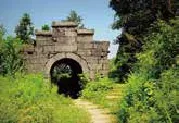问道岭南
问道岭南
All ROADS LEAD TO LINGNAN
Text by Peter Translation by Leo Photos by VCG & IC Illustration by Sandy
Ancient stone-paved roads And footprints of horses told of the long history of Lingnan.
Said to be the land of “Southern barbarians”, oldtime Guangdong, part of Lingnan (South of the Five Ridges), was not as isolated from the rest of China as many people imagined. Best evidence for this argument is the many historic trails that have been excavated and restored across the region. Historical data and remains show that more than 2,000 years ago the region was connected by multiple ancient roads to the North, West and East sides of the Five Ridges.
Like today's highways, these routes were important lines of communication through which tradesmen, travellers, migrants and materials in ancient times moved from Lingnan to the rest of China or vice versa. Some experts hold that, in those times, it was far easier to travel around the region along waterways than on roadways. Therefore, water channels like the South China Sea, along with the ancient roads, formed a network of transportation that thrived for more than 1,000 years.
The Meiguan Ancient Road that connects the Yangzi River and Pearl River systems is typical of all ancient trails in the region. It is a golden passage through which the north and the south of the Five Ridges communicated both economically and culturally.
Meandering from the city of Dayu in Jiangxi Province to the city of Nanxiong in Guangdong Province, the trail was uniquely positioned as one of the few gateways into Guangdong from the north of the Five Ridges. A pass was set up for military purposes on the Meiling Mountain at the border between Jiangxi and Guangdong in the Qin dynasty (221-206 BC), but years of war made it barely passable. In the Tang dynasty (618-907), then Prime Minister Zhang Jiuling was charged with the construction of a road that pierced the mountain barrier. In just two months, he cut an opening into the mountain and built a 3-metrewide and 15-km-long artery connecting Central China and South China.
As a Chinese saying goes, “A road is the fi rst step to fortune.” It is said that thousands of people travelled the route each day following its construction. Commercial taxes collected by the governments of nearby towns such as Nanxiong, Nan'an Jun and Qianzhou increased throughout the Northern Song dynasty (960-1127), indicating a boom in trade and commerce in the areas along the route. For this reason, the road has been well maintained since the Song dynasty.
Some famous poems were composed by poets when they passed by the Meiguan Pass. On his way to a new off i ce in Lianzhou (Guangdong) following his demotion, great poet Su Dongpo wrote, “The fading of plum blossoms is followed by the blooming of hundred fl owers; you didn't show up before all passers-by were gone.” Tang Xianzu (1550-1616), a highly successful playwright of the Ming dynasty (1368-1644), wrote The Peony Pavilion in his retirement, a play based on a romantic story that he heard of when he travelled along the route to Zhejiang Province in East China for a new off i cial post.
The ancestors of most native residents in today's Pearl River Delta region migrated by way of the Meiguan Ancient Road. One of the earliest settlements along the route was the town of Zhujixiang, which was home to thousands of households and merchants in its heyday in the Southern Song dynasty (1127-1279). These immigrants belonged to one of the 141 clans whose ancestral halls can still be seen today across the town and which attract many tourists.
In the last 100 years, the role of the ancient route has been replaced by modern means of transportation (railways, high-speed railways, motorways, etc.). Though postal stations and caravansaries are nowhere to be seen, the stone-paved path survives and continues to be trodden by tourists who come to see the plum blossoms. When plum trees in the south of the mountain begin to wear green buds in the warm month of March, those in the north start to blossom. A few months later, these trees will be heavily laden with fruits, which can be made into plum wine.
石板古道上,马蹄行进的哒哒声与留下的深浅印记,伴着岭南走过漫长岁月。

虽有南蛮之地的说法,但古时的广东并非人们认为的那样封闭,逐渐被挖掘、复原的古道便是最好的证据。从历史资料和现存遗迹中可发现,早在2000多年前,这里就有多条道路沟通五岭南北,和东西两翼的交往也从未中断。
作为古时的“高速公路”,古道上承载着南来北往的如梭商旅,物资云涌,氏族迁徙。有专家认为,古代的岭南一带,水道交通在很多时候要远远便捷于陆道。因此,广东古道不仅限于陆路,以南海通道为代表的水上交通,与陆上古道一同,构成了畅通千年的交通网络。
连接着长江与珠江的梅岭古道是岭南古道的代表,它是中国古代经济往来中水陆与陆路的枢纽对接点,也是南北文化交流的黄金通道。
南入广东南雄,北进江西大余,特有的地理位置让梅岭成为古代沟通五岭南北的咽喉。梅岭设关始于秦,秦代开的山道用于军事,历经战乱后不堪行走。至唐代,张九龄奉诏在此劈山开道,用了不过两个多月的时间,打通了一座大山坳,开设了一条宽一丈余,长三十多华里的山间大道,成为南北交通的大动脉。
路通财通,沿途的经济得以发展。自梅关古道修建以来,南来北往的商旅挑夫“日有数千”。北宋前期至中后期,梅岭道附近的南雄州、南安军、虔州等地商税都有增加,说明道路上商品交易的繁荣。因其重要,从宋代开始历朝历代都有修路之举。
经过梅关的人,还有不少文人墨客,他们在此留下了不少诗作。苏东坡被贬连州时,在古道留下了“梅花开尽杂花开,过尽行人君不来”。汤显祖在经古道赴浙江遂昌担任知县的途中,听闻了杜丽娘还魂的故事。五年后,辞官归里的他写下了“情不知所起,一往而深”的《牡丹亭》。
今天珠江三角洲的居民,其先祖也大多是经梅岭古道南迁的。位于古道上的珠玑巷成为了南迁先人的聚居地,南宋极盛时,珠玑巷内的商贩和居民多达数千户。历史上南迁的珠玑移民现今共有141姓,巷中大小祠堂林立,如今,这里已被开发成中国的姓氏文化旅游区。
粤汉铁路、雄余公路、323国道、京珠高速,近百年来,随着越来越先进便捷的道路先后开通,梅岭古道在交通方面的地位已被取代。驿站、马店淡出了视线,唯有石板路仍在,成为了游人们的赏梅之道。阳春三月,山南花落,山北始开。几个月后,青梅累累,梅酒飘香。
XIJING ANCIENT ROAD西京古道
As little historical data is available, many details about the Xijing Ancient Road remain unknown.
Located within Daqiao Town about 40 km from the seat of Ruyuan Yao Autonomous County in northern Guangdong, the route was fi rst built in the sixth year of Emperor Wu's Jianyuan Era (135 BC) and was one of the few ways to Chang'an (today known as Xi'an), the capital of the Tang dynasty. Some of the bridges, pavilions and cottages along the route have survived the vicissitudes of time.


SHUNTOULING RIDGE ANCIENT ROAD顺头岭古道
Built about 1,000 years earlier than the Meiguan Ancient Road, the Shuntouling Ridge Ancient Road was the fi rst of its kind to connect central China with south China. With this post road traversing it, the city of Lianzhou in northwestern Guangdong became one of the fi rst developed areas in Lingnan. By the Tang dynasty, the city was home to more than 30,000 registered residents and was one of the three key administrative centres across Lingnan, along with Shaozhou
(today's Shaoguang) and Guangzhou.
TRACING ANCIENT ROUTES IN GUANGDONG
古道寻踪
CHENGJIA ANCIENT ROAD
秤架古道
The Chengjia Ancient Road meanders through the 1,000m-high mountains in the northeast of Yangshan County in the city of Qingyuan. With a varying width of 50-95 cm, the narrow winding trail is basically in good condition. It is believed that the path was fi rst built for off i cial use before being turned into a commercial route.

ANCIENT MULE-HORSE ROAD骡马古道
A poem by Du Mu, a poet of the Tang dynasty, read: “A horse gallops across the land at full speed, and the concubine laughs. Who else knows it is lychees coming.” The Ancient Mule-Horse Road was the exact route through which lychees were painstakingly carried from Guangdong to Chang'an to please Yang Guifei, the favorite concubine of Emperor Xuanzong (685-762). Also known as Hunan-Guangdong Ancient Road, the trail stretched from a village in Shaoguan to the city of Chenzhou in the south of Hunan Province. The path, completely coved with stone together with the footprints left by working horses and mules, was testimony to the boom in trade and commerce of the time and beyond.


GOAT HOOF RIDGE ANCIENT ROAD羊蹄岭古道
Located within Haifeng County in the east of Guangdong, the Goat Hoof Ridge Ancient Road is a route running east-west through the Lotus mountain range, a branch of the Five Ridges. According to an expert in cultural history, there is still a 15km-long intact section of the historic road of varying width.

